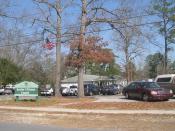ELDERLY DRIVERS
Driving is a simple task that many of us do on a daily basis. Most people are safe drivers, while a few are incapable of driving safely. Safe and capable is how most senior citizens can be viewed; however, there are some drawbacks that can make a senior citizen dangerous behind the wheel. Some of the problems with the elderly today are that their reflexes react slower, they are hearing impaired, or a physical health change can be a big problem. Research has shown everyone ages differently and growing old does not necessarily mean a person becomes a safety hazard on the road. Much depends on the person's physical and mental health as the years pass. Because people age differently there should be certain test given to the elderly after the age of 65.
First, an annual hearing test should be given to the elderly. About thirty percent of those over age 65 are hearing impaired.
The ability to hear is more important to driving than most people realize. Hearing can warn a driver of danger signals like the sound of screaming sirens, honking horns, or screeching tires. There are occasions when a driver can hear a car but can't see it because of a blind spot. Good hearing helps drivers to be sensitive to what is happening on the roadways around them.
Secondly, An annual visual acuity test should be given to the elderly. The elderly are not tested periodically so more often than not visual changes occur and go undetected. Passing a simple eye-test should guarantee clear sight. But many elderly people have visual defects that make it difficult for them to see road signs and pedestrians. Senior citizens may need to slow their vehicles to read a road sign, which can put them at risk...



Good essay
I don't know how many times I've pulled up behind a large Cadillac driving 20 mph below the speed limit and I couldn't see the driver. When I passed it, I would always see some Geritol blue-hair little old lady peering over the steering wheel with coke-bottle-bottom glasses chatting to her friend. Nothing against senior drivers, but there should be measures taken to ensure that they are safe on the road.
One point, however, about the hearing test. Requiring good hearing may discriminate against the thousands of good drivers that are legally deaf.
Good thought flow, organization and structure. Great paper.
6 out of 6 people found this comment useful.